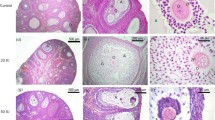Abstract
The effect of super-ovulatory dose of pregnant mare serum gonadotropin and human chorionic gonadotropin on ovulation, advancement of ovulation, subsequent embryo development and implantation were studied in the hamster. Groups of hamsters received pregnant mare serum gonadotropin injection on day 1 of the estrous cycle followed by human chorionic gonadotropin injection either at 56 or 76 h later, pregnant mare serum gonadotropin alone on day 1 or human chorionic gonadotropin alone on day 3.
The combination therapy (pregnant mare serum gonadotropin and human chorionic gonadotropin) resulted in super-ovulation (an average of 40 mature ova/animal) while human chorionic gonadotropin alone yielded an average of 10 mature ova/animal. Ovulation was advanced by 24 h by giving human chorionic gonadotropin at 56 h instead of 76 h after pregnant mare serum gonadotropin. Subsequent embryo development and implantation occurring under different hormonal regimens were studied. The ova obtained by giving human chorionic gonadotropin injection at 56 h were poorly fertilizablein vivo and hence the pregnancy rate was low (6 %). These ova however, were fertilizablein vitro, suggesting that the low fertilization rate and developmental failure may be due to inhibition of sperm capacitation/transport because of premature human chorionic gonadotropin administration. In the group receiving human chorionic gonadotropin alone on day 3 there was fertilization and cleavage, but no implantation occurred due to failure of functional corpora lutea. However, administration of progesterone and estrone from day 2 of gestation resulted in 80% implantation and sustenance of pregnancy. On the other hand, the pregnant mare serum gonadotropin and human chorionic gonadotropin combination therapy resulted in super-pregnancy. The number of fetuses present at term was higher in the group receiving pregnant mare serum gonadotropin alone than in the group receiving the combination therapy. Embryo resorption however was higher (37%) in the latter group compared with the former (9.5%). However, preimplantation embryos were found to be viable as evidenced by fluorescein diacetate staining.
Similar content being viewed by others
Abbreviations
- PMSG:
-
Pregnant mare serum gonadotropin
- hCG:
-
human chorionic gonadotropin
- HSA:
-
human serum albumin
- PBS:
-
phosphate buffered saline
- 0.01 M pH 7.4,0.9 NaCl:
-
normal saline
- FDA:
-
fluorescein diacetate
References
Biggers, J. D., Whitten, W. K., Whittingham, D. G. (1971) inMethods in Mammalian Embryology (ed. J. C. Daniel) (San Francisco: Freeman) p. 86.
Chang, M. C. (1970) inAdvances in the Bioscience (ed. G. Raspe) (Germany: Brown Schweig, F. Vieweg and Sohn)VoI 4, p. 13.
Fleming, A. D. and Yanagimachi, R. (1980)Dev. Growth Differ.,22, 103.
Greenwald, G. S. (1979)Ann, Biol. Anim. Biochem. Biophys.,19, 1483.
Mohr, L. R. and Trounson, A. O. (1980)J. Reprod. Fertil.,58, 189.
Orsini, M. W. and Psychoyos, A. (1965)J. Reprod. Fertil.,10, 300.
Rotman, B. and Papermaster, B. W. (1966)Proc. Natl. Acad. Sci. USA.,55, 134.
Sehgal, S. and Diamond, M. (1977)Biol. Reprod.,16, 370.
Yanagimachi, R. and Chang, M. C. (1964).J. Exp. Zool.,156, 361.
Author information
Authors and Affiliations
Rights and permissions
About this article
Cite this article
Peter, J., Menezes, J. Effect of super-ovulatory doses of pregnant mare serum gonadotropin and human chorionic gonadotropin in blastocyst implantation in golden hamsters. J Biosci 6 (Suppl 2), 75–82 (1984). https://doi.org/10.1007/BF02716718
Issue Date:
DOI: https://doi.org/10.1007/BF02716718




